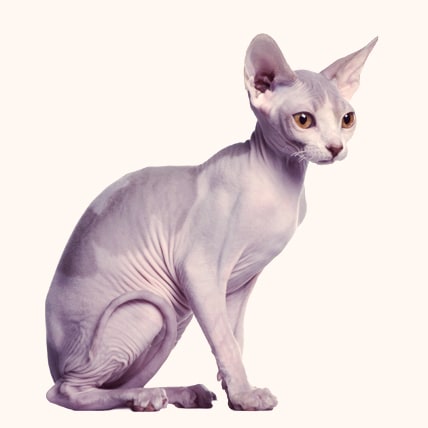Type the name of the breed you're looking for below
[wpdreams_ajaxsearchlite] Don't see the breed your're looking for? Click here and let us know!
Breed Characteristics
1 paw - breed exhibits the least amount of this characteristic
5 paws - breed exhibits most amount of this characteristic
Sphynx
| Origin And History | The Sphynx is not the first instance of hairlessness in domestic cats. This natural, spontaneous mutation has been seen in various locations around the world for at least the last ninety-something years, and probably longer. The Book of the Cat (Simpson, 1903), mentioned a pair of hairless cats belonging to a New Mexico fancier. Called the 'Mexican Hairless', these cats supposedly were obtained from Indians around Albuquerque. In 1950 a pair of Siamese cats in Paris, France, produced a litter that included three hairless kittens. The results were repeated in subsequent mating of the same pair, but breeding the parents to other Siamese cats produced no new hairless kittens. Other hairless specimens turned up in Morocco, Australia, North Carolina, and, in 1966, in Canada, where a pair of domestic shorthairs produced a litter that included a hairless kitten. A breeder named Ryadh Bawa obtained the parents and, with the help of other breeders, began a breeding program. The CFA originally granted New Breed and Color status, then in 1971 they withdrew recognition due to infertility problems with the breed. This line was not pursued after 1980 and is not part of the current bloodline. The breed as we know it today began in 1975, when Minnesota farm owners Milt and Ethelyn Pearson discovered that a hairless kitten had been born to their normal-coated farm cat, Jezabelle. This kitten, named Epidermis, was joined the next year by another hairless kitten named Dermis. Both were sold to Oregon breeder Kim Mueske, who used the kittens to develop the breed. Georgiana Gattenby of Brainerd, Minnesota, also worked with kittens from the Pearson line, using Cornish Rex as an outcross. At almost the same time (1978), Siamese breeder Shirley Smith of Ontario, Canada, found three hairless kittens on the streets of her neighborhood. In 1983 she sent two of them to Dr. Hugo Hernandez in the Netherlands. Dr. Hernandez bred the two kittens, named Punkie and Paloma, to a white Devon Rex named Curare van Jetrophin. The descendants of these cats, along with the descendants of the cats from Minnesota and Oregon, became the foundation of today's Sphynx breed. The breed has made considerable strides since its inception due to a small group of dedicated breeders. While most fanciers have welcomed the Sphynx as unique and exotic, some members of the cat fancy wish that the Sphynx would put on some clothes. Like other breeds that have diverged from the basic design, the Sphynx has drawn some negative attention. Also, the gene that governs hairlessness can be considered a genetic disorder, since the cat is more susceptible to both heat and cold. On the other hand, fanciers argue that we humans are pretty much hairless ourselves compared with our closest relatives, and we?ve managed to get by pretty well. Breeders and fanciers are currently working toward CFA recognition. The Sphynx would be required to come in as a new breed, rather than one previously recognized. |
| Personality | Sphynxes are known for their extroverted behavior. They display a high level of energy, intelligence, curiosity, and affection for their owners. They are one of the more dog-like breeds of cats, frequently greeting their owners at the door and friendly when meeting strangers. |
Physical Attributes
| Appearance | Sphynx are medium sized substantial cats and not fragile in any way. As with most cats, adult males are larger than females. Sphynx have sturdy boning, good muscle development and a bit of a firm belly as if they just finished a nice dinner. They have an open-eyed and intelligent expression with extra wrinkling on their head which some see as a worried or inquisitive look. The Sphynx only appears hairless, its skin, or parts of it, is covered with a fine, almost imperceptible vestigial covering of down that gives the skin the texture of chamois. Heterozygous Sphynxes (those that possess only one copy of the hairless gene) usually exhibit more hair than homozygous Sphynxes (those possessing two copies). Wrinkles are a desirable trait in the show Sphynx. He isn't really more wrinkled than any other cat, though; you can see the wrinkles because of the lack of fur. The lack of coat makes the Sphynx feel like warm suede to the touch. |
| Health | The Canadian Sphynx face challenges unique to their nature. The lack of hair can cause health issues with kittens in the first weeks of life because of susceptibility to respiratory infections. Reputable breeders will not let their kittens go to new homes without being at least 12 weeks of age to ensure the kitten is mature enough to cope in a new environment. Because of their lack of protective fur, skin cancer may be a problem if exposed to sunlight for long durations of time. The breed does have instances of the genetic disorder hypertrophic cardiomyopathy (HCM). Studies are being undertaken to understand the links in breeding and the disorder. The Sphynx cat has a severe problem with heart disease, either HCM or mitral valve dysplasia. In a study of 114 cats, 34% were found to have an abnormal heart. 16 had mitral valve dysplasia and 23 had HCM. These prevalence's were found in cats with an average age of 2.62 years. A type of muscular dystrophy associated with alpha-dystroglycan deficiency, and similar to that seen in Devon Rex cats, has also been described, but is rarely seen. |



